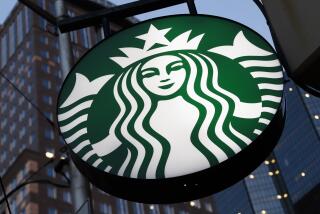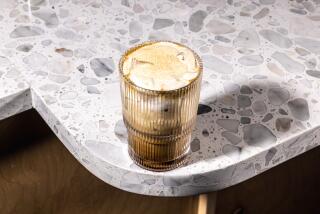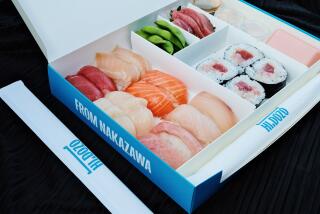With Tokyo Store, Starbucks Hopes to Give Japan Its Joe
TOKYO â Thereâs a new buzz in town. This week, Starbucks Coffee took a high-risk plunge into its first overseas market, Japan, land of $5 cups of coffee, chronically sleep-starved consumers and intense competition to supply their daily caffeine fix.
The Seattle-based Starbucks has opened its green-and-terra-cotta store in the posh Ginza district at a time when the coffee retailing market here is more competitive than ever.
Coffee has supplanted green tea as Japanâs most popular beverage. According to the All Japan Coffee Assn., coffee consumption has risen about sixfold since 1980, while tea green consumption fell 8%.
Japan is now the worldâs third-largest importer of coffee, after the United States and Germany.
The coffee shop (written with the Chinese characters as âsmoking and tea shopâ) has a special role in Japan, where homes are too cramped and often too far from downtown for much entertaining and where few workers have private offices. It is a place to sneak away to during the workday, to talk business (or baseball) with clients and colleagues, to meet friends and to romance lovers or just to take a respite from Tokyoâs crowds and breakneck pace.
At the high end of the market, a few glamorous shops offer cappuccino for nearly $7 a cup. The chairs face the street, as at an elegant Parisian cafe where the point is to people-watch and be seen.
One notch down is the Renoir chain, which charges more than $4.50 per cup--no refills--but allows customers to hold business meetings and read or nap undisturbed in its plush armchairs for up to two hours for the price of a cup.
*
âIf you go in there at 11 a.m., the place is full of middle-aged men playing hooky from work, and theyâre out cold all over the place,â said travel agent Frank Kagiyama, who visits coffee bars to sate his seven- or eight-cup-a-day habit.
Toward the low end of the market are McDonaldâs and other fast-food shops, where $2 buys a cup of iced coffee to provide a jolt for the sweaty workers who pour out of jammed commuter trains each morning.
Japanâs worst postwar recession has created a big market for discount coffee shops such as Pronto, which charges just $1.50 for a cup and has opened more than 72 stores throughout Japan since 1987. Starbucks, which already has a following among well-traveled Japanese consumers, is aiming at the center of the market by pricing regular coffee at $2.35 per cup and cappuccino at $2.65.
On advice from Starbucksâ Japanese joint-venture partner, Sazaby Inc., the baked goods on offer are not as sweet as those in the United States, and there is no decaffeinated coffee on the menu; it has not yet caught on in Japan.
But the dark-roasted coffee, the decor, the Seattle-trained, hip-looking employees, the T-shirts and even the music are identical to those in American stores.
On Friday, the storeâs opening day, Kagiyama and his travel-agency buddies said they liked the Starbucks coffee, pronounced the prices reasonable and decided the bright, airy space would be perfect for their meetings. But like many hard-pressed Japanese consumers, they wished they could get more bang for their yen.
âI had the cheese croissant,â Kagiyama said. âIt was good. But it was Japanese-sized, not American-sized.â
(BEGIN TEXT OF INFOBOX / INFOGRAPHIC)
Java in Japan
The number of Japanese coffee devotees has risen sharply since 1980; there are now 87 million coffee drinkers. Men ages 25-39 sip the most--more than 15 cups per week. Women 60 and older drink the least.
Cups consumed per week / % of respondents in poll about coffee drinking habits:
None
1980: 29%
1994: 16%
1 to 7 cups
1980: 33%
1994: 35%
8 to 20 cups
1980: 30%
1994: 34%
21 cups or more
1980: 9%
1994: 15%
Source: All Japan Coffee Assn.
More to Read
Eat your way across L.A.
Get our weekly Tasting Notes newsletter for reviews, news and more.
You may occasionally receive promotional content from the Los Angeles Times.










